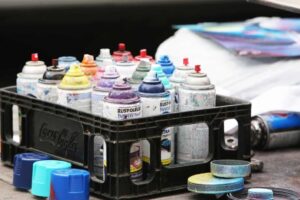Is paint flammable? It’s a question that many people have, and in this article, we’ll provide the answers you need. From oil-based paints to water-based options, we’ll cover the flammability of different types of paint and the potential fire hazards they may pose in your home or workspace.
Paint is generally not flammable, but some types of paint may be more flammable than others. Oil-based paints tend to be more flammable than water-based paints because they contain solvents that are highly flammable. Latex paints, on the other hand, are water-based and generally not flammable.
However, it is important to note that all paints can burn under the right conditions, such as if they are exposed to high heat or an open flame. It is also important to follow the safety instructions on the label of the paint and to store paint in a cool, dry place away from heat sources and flames.
Is paint flammable?

Paint is generally not highly flammable, but it can be combustible under certain conditions. The flammability of paint depends on the type of paint and the specific ingredients used to make it. Some types of paint, such as oil-based paints, are more flammable than others, such as water-based paints.
Oil-based paints contain solvents that can be flammable and may ignite if they come into contact with an open flame or another ignition source. Water-based paints, on the other hand, are less flammable because they do not contain solvents. They may still burn, but they are less likely to ignite and will generally burn less intensely if they do catch fire.
The flammability of paint can also be affected by the presence of other flammable materials in the paint, such as pigments or fillers. In general, paints that contain a high percentage of volatile organic compounds (VOCs) are more flammable than those with low VOC levels.
It is important to store paint in a cool, dry place away from heat sources and open flames and to use caution when using and handling paint, especially around open flames or other sources of ignition.
What kind of paint is not flammable?
Water-based paints are generally considered to be non-flammable or less flammable than oil-based paints. This is because water-based paints do not contain flammable solvents as oil-based paints do. Water-based paints may still burn if they come into contact with an ignition source, but they are less likely to ignite and will generally burn less intensely if they do catch fire.
In addition to water-based paints, there are also other types of paints that are specifically designed to be non-flammable or have low flammability. These include intumescent coatings, which are used to protect structural steel and other materials from fire, and fire retardant paints, which are used to reduce the risk of fire in a variety of applications.
It is important to note that all paints have the potential to burn under certain conditions, and it is important to use caution when handling and storing any type of paint.
How to store paint safely to prevent fire?
Proper storage of paint is important for preventing fires and ensuring the safety of both you and your home. Here are some tips for storing paint safely to prevent fire:
- Store paint in a cool, dry place away from heat sources and open flames.
- Keep paint containers tightly sealed when not in use to prevent evaporation and the buildup of flammable vapors.
- Do not store paint near sources of ignition, such as hot water heaters, furnaces, and pilot lights.
- Do not store paint in direct sunlight or other areas where the temperature may become too high.
- Follow the manufacturer’s instructions for the proper storage of the specific type of paint you are using.
- Keep a fire extinguisher nearby in case of an accidental fire.
- Regularly check the expiration date on the paint and dispose of any that have expired. Expired paint may become more flammable over time.
By following these guidelines, you can help to reduce the risk of fire associated with the storage of paint.
Can paint fumes catch fire?
Paint fumes are the gases that are released into the air when the paint is applied and dried. These fumes can be flammable under certain conditions. The flammability of paint fumes depends on the type of paint and the specific ingredients used to make it. Some types of paint, such as oil-based paints, produce more flammable fumes than others, such as water-based paints.
Oil-based paints contain solvents that can be flammable and may ignite if they come into contact with an open flame or other ignition sources. Water-based paints, on the other hand, are less flammable because they do not contain solvents. They may still produce fumes that can burn, but they are less likely to ignite and will generally burn less intensely if they do catch fire.
The flammability of paint fumes can also be affected by the presence of other flammable materials in the paint, such as pigments or fillers. In general, paints that contain a high percentage of volatile organic compounds (VOCs) produce more flammable fumes than those with low VOC levels.
It is important to use caution when handling and using paint, especially around open flames or other sources of ignition, and to ensure that the area is well-ventilated to help dissipate the fumes.
What to do if paint catches fire?

If paint catches fire, it is important to act quickly and take the following steps to extinguish the fire:
- If the fire is small and contained, such as a paintbrush or roller that has caught fire, try to extinguish it using a fire extinguisher. Aim the nozzle at the base of the flames, and use a sweeping motion to cover the entire area.
- If the fire is larger, or if you are unable to extinguish it with a fire extinguisher, evacuate the area immediately and call the fire department. Do not try to fight the fire yourself if it is beyond your control.
- Close any doors and windows to prevent the fire from spreading.
- Do not use water to extinguish a fire involving paint. Water can cause the paint to spread and may make the fire worse.
- If you are unable to evacuate the area, move to a room with a door that can be closed to contain the fire. Stay low to the ground to avoid inhaling smoke and fumes.
You can help to minimize the risk of injury and damage caused by a fire involving paint if you follow the instruction above.
How to test if the paint is flammable?
Testing the flammability of paint is important for ensuring the safety of your home and workspace. Here are some steps you can take to test if the paint is flammable:
- Check the label on the paint can for flammability warnings or information about the specific type of paint. Some paints are labeled as non-flammable or have a low flammability rating.
- Determine the type of paint you are using. Oil-based paints are generally more flammable than water-based paints.
- Perform the fire point test to determine the flash point of the paint. To do this, heat a small sample of the paint in a metal container using a Bunsen burner. The temperature at which the paint ignites is its flash point. The lower the flash point, the more flammable the paint.
- Use caution when handling and using paint, especially around open flames or other sources of ignition.
By following these steps, you can determine the flammability of the paint you are using and take appropriate precautions to prevent fires. It is important to note that all paints have the potential to burn under certain conditions, and it is important to use caution when handling and storing any type of paint.
How to dispose of flammable paint safely?
Proper disposal of flammable paint is important for preventing fires and protecting the environment. Here are some steps you can take to dispose of flammable paint safely:
- Check with your local waste management agency to see if they have specific guidelines for the disposal of flammable paint. Some areas may have regulations regarding the disposal of hazardous materials.
- If the paint is still in good condition, consider donating it to a school or community center for use in art projects or other activities.
- If the paint is no longer usable, it can be disposed of at a household hazardous waste collection facility. These facilities are specifically designed to handle and safely dispose of hazardous materials, such as flammable paint.
- If you are unable to dispose of the paint at a household hazardous waste collection facility, you may be able to dispose of it at a hazardous waste landfill. Contact your local waste management agency for information on how to do this.
With these steps, you can help to ensure that flammable paint is disposed of safely and in an environmentally responsible manner.
Can flammable paint be used on walls?
It is generally not recommended to use flammable paint on walls. Most paints are made with a flammable solvent, such as mineral spirits, which can ignite if exposed to an open flame or high heat. In addition, many paints release volatile organic compounds (VOCs) when they are applied, which can contribute to poor indoor air quality and may be harmful if inhaled in large amounts.
There are some specialized paints that are designed to be more fire-resistant, such as those used in fireproofing buildings or on ships and airplanes. These paints are typically made with a non-flammable solvent and are formulated to resist ignition. However, they are not generally recommended for use on walls in residential or commercial buildings.
If you are concerned about fire safety in your home or business, there are other measures you can take to reduce the risk of fire. These include installing smoke detectors, keeping flammable materials away from heat sources, and having an evacuation plan in place.
What are the safety precautions for using flammable paint?
There are several safety precautions you should take when using flammable paint:
1. Use in a well-ventilated area: Make sure the area where you are using the paint is well-ventilated to reduce the risk of inhaling vapors from the paint.
2. Keep away from open flames: Do not use flammable paint near open flames or sources of heat, as this can increase the risk of fire.
3. Store properly: Keep flammable paint in a cool, dry place away from heat sources and open flames.
4. Follow the manufacturer’s instructions: Read and follow the instructions on the paint label carefully, including any warnings and precautions.
5. Wear protective clothing: Wear protective clothing, such as gloves, goggles, and a face mask, to avoid contact with the paint and to protect yourself from inhaling vapors.
6. Keep a fire extinguisher handy: In case of a fire, have a fire extinguisher readily available to help put out the flames.
What are the fire hazards of using flammable paint?

Flammable paint poses several fire hazards:
1. Vapors: Many paints release vapors as they dry, which can ignite if they come into contact with an open flame or heat source.
2. Solvent: Most paints are made with a flammable solvent, such as mineral spirits, which can ignite if exposed to an open flame or high heat.
3. Volatile organic compounds (VOCs): Many paints release volatile organic compounds (VOCs) when they are applied, which can contribute to poor indoor air quality and may be harmful if inhaled in large amounts.
4. Flammable residues: After the paint has dried, flammable residues may remain on surfaces and can pose a fire hazard if they come into contact with an open flame or heat source.
To reduce the risk of fire when using flammable paint, it is important to use the paint in a well-ventilated area, keep it away from open flames and heat sources, and follow the manufacturer’s instructions for use. It is also a good idea to keep a fire extinguisher handy in case of an accidental fire.
Is it legal to use flammable paint?
In most cases, it is legal to use flammable paint as long as it is used in accordance with the manufacturer’s instructions and local laws and regulations. However, there may be certain situations where the use of flammable paint is prohibited, such as in buildings with a high occupancy rate or in areas where there is a risk of fire spreading quickly.
It is important to follow all local laws and regulations regarding the use of flammable paint, as well as any safety guidelines provided by the manufacturer. In addition, you should take appropriate safety precautions when using flammable paint to reduce the risk of fire and protect yourself and others from injury.
How to choose a non-flammable paint?
To choose a non-flammable paint, you should look for a paint that is formulated with a non-flammable solvent, and that has a low volatility rate. Non-flammable solvents include water, oil, and latex. Paints that are water-based or oil-based are generally less flammable than those that are made with a solvent, such as mineral spirits.
In addition to the solvent used in the paint, you should also consider the volatility rate of the paint. Volatility refers to the rate at which a substance evaporates. Paints with a low volatility rate are less flammable than those with a high volatility rate.
To ensure that you are choosing a non-flammable paint, you should read the label carefully and look for any warnings or precautions related to flammability. Some paints are labeled as “fire-resistant” or “non-combustible,” which indicates that they are less likely to ignite or contribute to the spread of fire.
It is also a good idea to consult with a professional or do some research to determine which type of paint is best suited for your needs.
Can flammable paint be used near a fireplace?
It is generally not recommended to use flammable paint near a fireplace or any other open flame. If the paint were to catch fire, it could quickly spread and potentially cause a serious fire. In addition, the fumes from the burning paint could be toxic and potentially harmful to breathe in.
It is important to use caution when selecting and using paints, especially in areas where there is a risk of fire. It is generally safer to use non-flammable paints in these types of areas.
If you are planning to paint in an area near a fireplace or other open flame, it is a good idea to consult with a professional or refer to the safety instructions on the paint label to ensure that you are using a safe and appropriate product.
Recommended:
What are the alternatives to flammable paint?
There are several alternatives to flammable paint that you can use depending on your needs and the specific application. Some options include:
1. Water-based paint: This type of paint is made with water as the main solvent, rather than volatile organic compounds (VOCs) like flammable paint. Water-based paint is generally less toxic and easier to clean up than flammable paint, and it is also less flammable.
2. Latex paint: This type of paint is made with a synthetic rubber or plastic binder, and it is also water-based. Like water-based paint, latex paint is less toxic and less flammable than flammable paint.
3. Acrylic paint: This type of paint is made with an acrylic polymer binder and is water-based. Acrylic paint is very durable and resistant to fading, and it is also less toxic and less flammable than flammable paint.
4. Epoxy paint: This type of paint is made with a two-part system that consists of a resin and a hardener. Epoxy paint is very durable and resistant to chemicals, and it is also non-flammable.
5. Powder coating: This is a dry finishing process in which a powder made of finely ground particles of pigment and resin is applied to a surface and then cured under heat to create a protective finish. Powder coating is non-toxic and non-flammable, and it is also very durable.
Conclusion
This page is all you need to know on the topic is paint flammable. Paint can be flammable or non-flammable depending on its ingredients and method of application. Flammable paint is made with volatile organic compounds (VOCs) as the main solvent, which can ignite easily and burn quickly.
Non-flammable paint, on the other hand, is made with water or a synthetic binder as the main solvent and is less likely to ignite or burn. It is important to choose the right type of paint for your specific needs and to follow proper safety precautions when using flammable paint.


